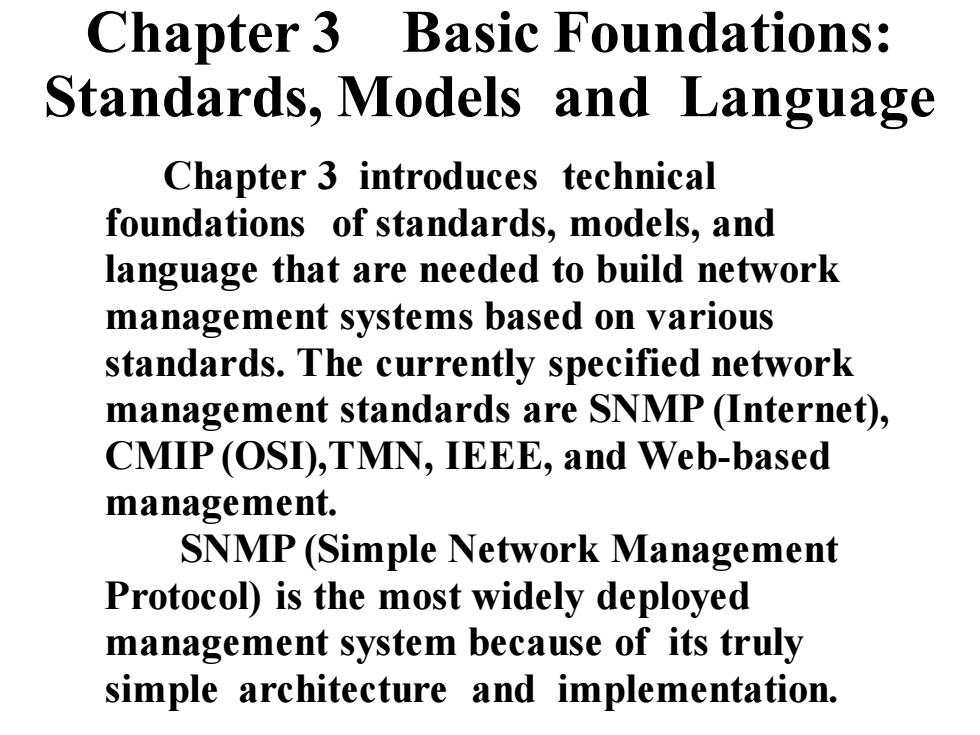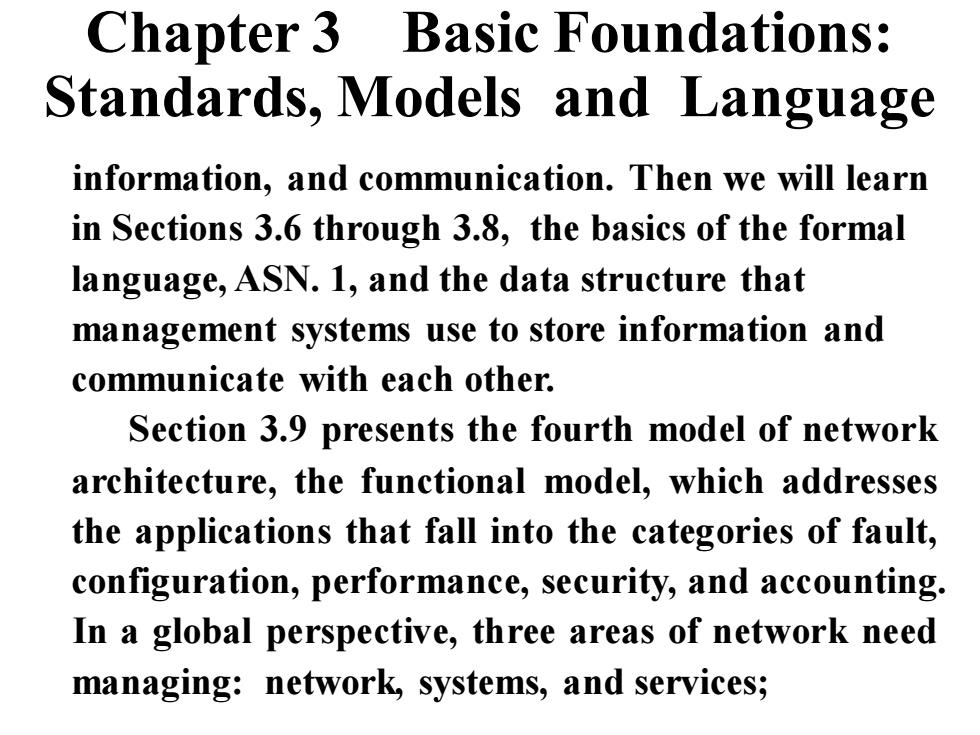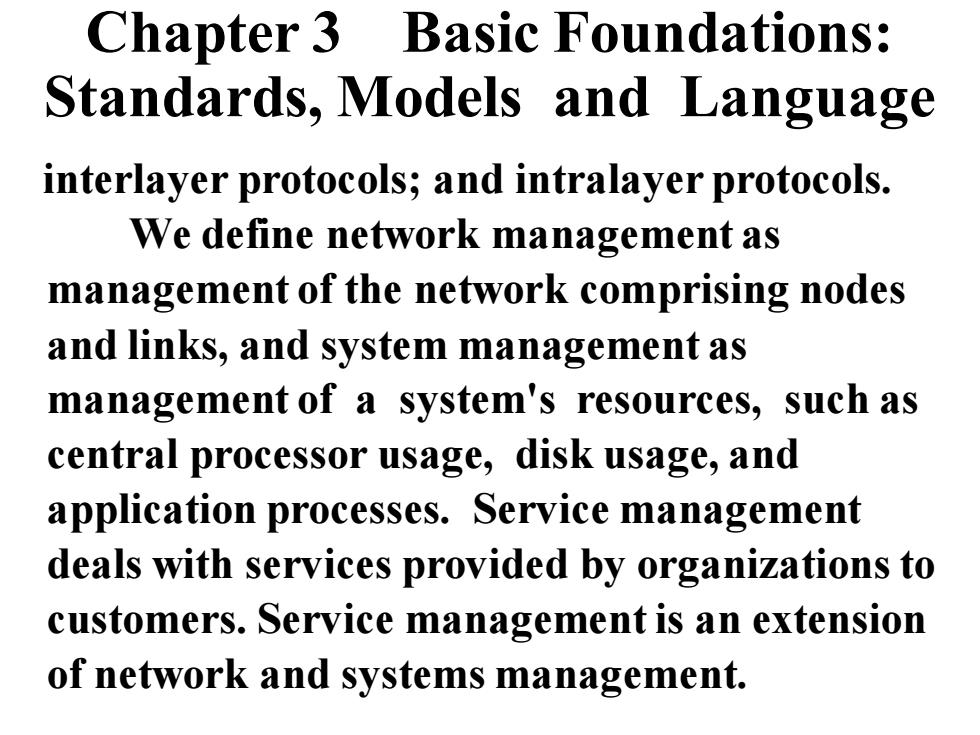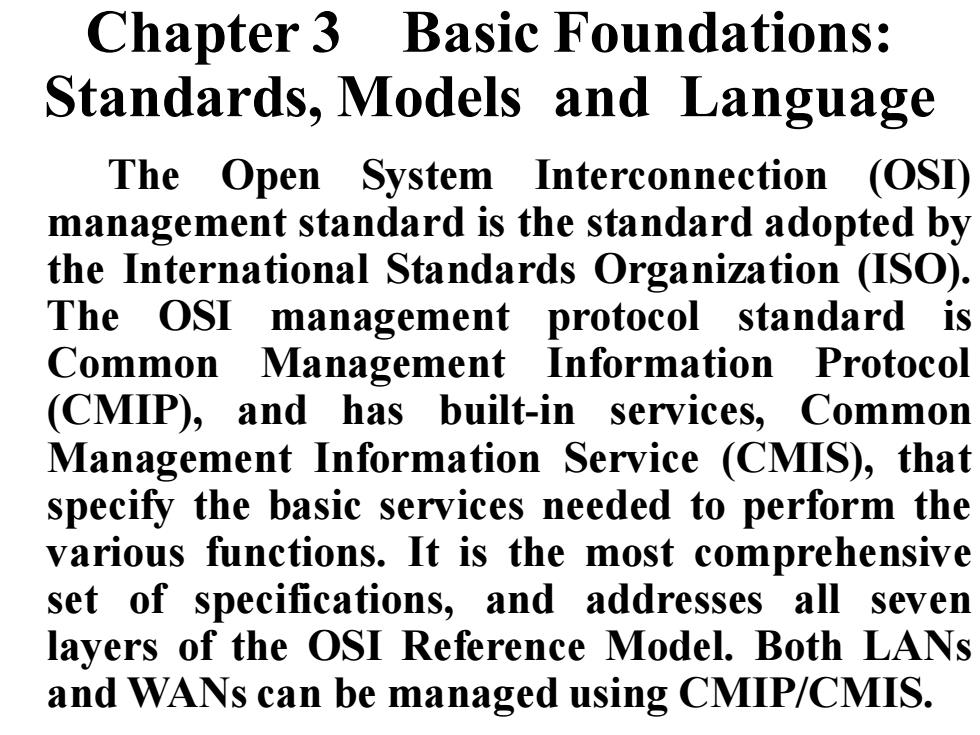
Chapter 3 Basic foundations: Standards,Models and Language Chapter 3 introduces technical foundations of standards,models,and language that are needed to build network management systems based on various standards.The currently specified network management standards are SNMP (Internet), CMIP (OSD),TMN,IEEE,and Web-based management. SNMP (Simple Network Management Protocol)is the most widely deployed management system because of its truly simple architecture and implementation
Chapter 3 Basic Foundations: Standards, Models and Language Chapter 3 introduces technical foundations of standards, models, and language that are needed to build network management systems based on various standards. The currently specified network management standards are SNMP (Internet), CMIP (OSI),TMN, IEEE, and Web-based management. SNMP (Simple Network Management Protocol) is the most widely deployed management system because of its truly simple architecture and implementation

Chapter 3 Basic Foundations: Standards,Models and Language To manage networks,systems,and services,there are several management standards and models in existence. We will consider the foundations of various network management models and protocols,survey the network management standards,and present the general architecture of network management models in Section 3.1. The International Standards Organization has defined a generalized model that addresses all aspects of network management.This is discussed in Section 3.2.In Sections 3.3 through 3.5 we cover the three models of the architecture that deal with organization
Chapter 3 Basic Foundations: Standards, Models and Language To manage networks, systems,and services, there are several management standards and models in existence. We will consider the foundations of various network management models and protocols, survey the network management standards, and present the general architecture of network management models in Section 3.1. The International Standards Organization has defined a generalized model that addresses all aspects of network management. This is discussed in Section 3.2. In Sections 3.3 through 3.5 we cover the three models of the architecture that deal with organization

Chapter 3 Basic Foundations: Standards,Models and language information,and communication.Then we will learn in Sections 3.6 through 3.8,the basics of the formal language,ASN.1,and the data structure that management systems use to store information and communicate with each other. Section 3.9 presents the fourth model of network architecture,the functional model,which addresses the applications that fall into the categories of fault, configuration,performance,security,and accounting In a global perspective,three areas of network need managing:network,systems,and services;
Chapter 3 Basic Foundations: Standards, Models and Language information, and communication. Then we will learn in Sections 3.6 through 3.8, the basics of the formal language, ASN. 1, and the data structure that management systems use to store information and communicate with each other. Section 3.9 presents the fourth model of network architecture, the functional model, which addresses the applications that fall into the categories of fault, configuration, performance, security, and accounting. In a global perspective, three areas of network need managing: network, systems, and services;

Chapter 3 Basic Foundations: Standards,Models and Language interlayer protocols;and intralayer protocols. We define network management as management of the network comprising nodes and links,and system management as management of a system's resources,such as central processor usage,disk usage,and application processes.Service management deals with services provided by organizations to customers.Service management is an extension of network and systems management
Chapter 3 Basic Foundations: Standards, Models and Language interlayer protocols; and intralayer protocols. We define network management as management of the network comprising nodes and links, and system management as management of a system's resources, such as central processor usage, disk usage, and application processes. Service management deals with services provided by organizations to customers. Service management is an extension of network and systems management

Chapter 3 Basic Foundations: Standards,Models and Language The Open System Interconnection (OSD) management standard is the standard adopted by the International Standards Organization (ISO). The OSI management protocol standard is Common Management Information Protocol (CMIP),and has built-in services,Common Management Information Service (CMIS),that specify the basic services needed to perform the various functions.It is the most comprehensive set of specifications,and addresses all seven layers of the OSI Reference Model.Both LANs and WANs can be managed using CMIP/CMIS
Chapter 3 Basic Foundations: Standards, Models and Language The Open System Interconnection (OSI) management standard is the standard adopted by the International Standards Organization (ISO). The OSI management protocol standard is Common Management Information Protocol (CMIP), and has built-in services, Common Management Information Service (CMIS), that specify the basic services needed to perform the various functions. It is the most comprehensive set of specifications, and addresses all seven layers of the OSI Reference Model. Both LANs and WANs can be managed using CMIP/CMIS